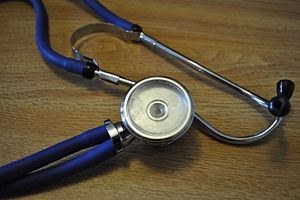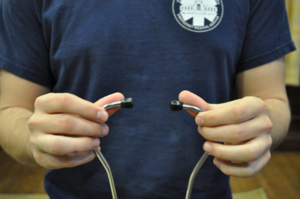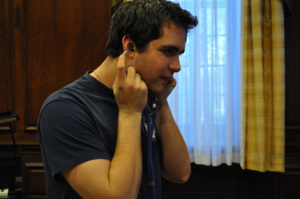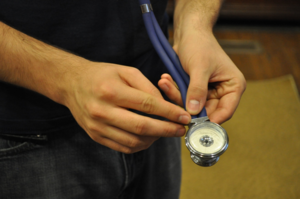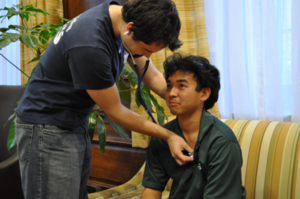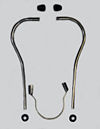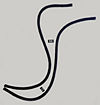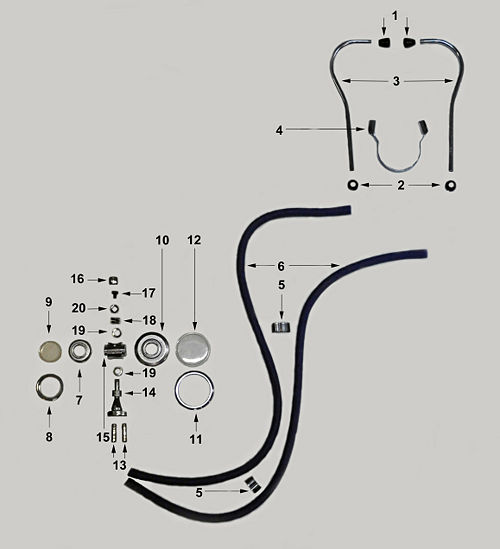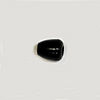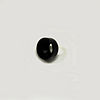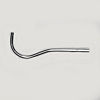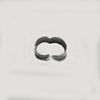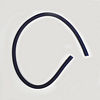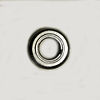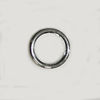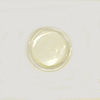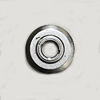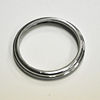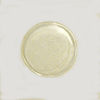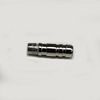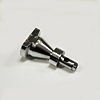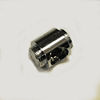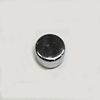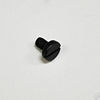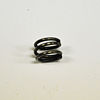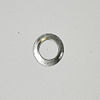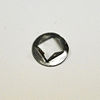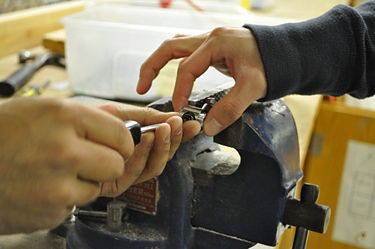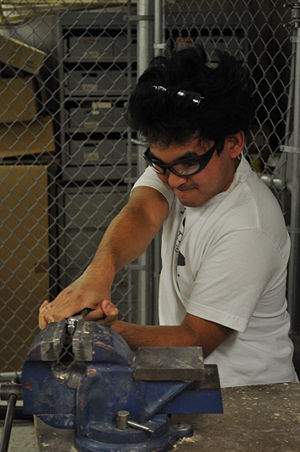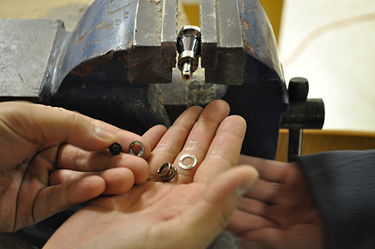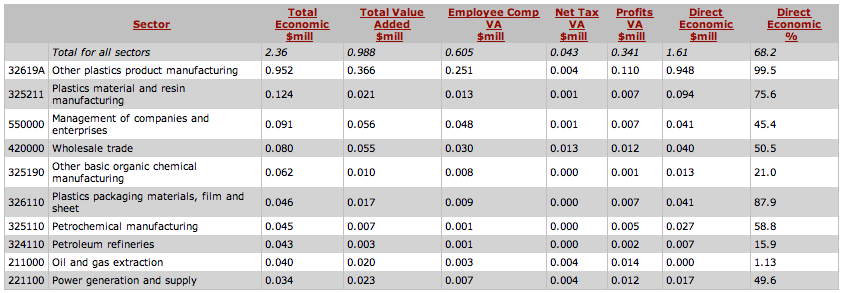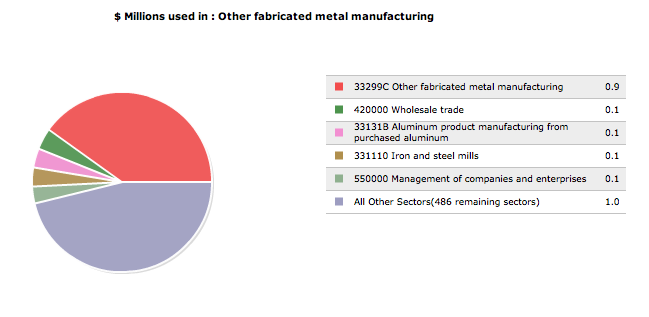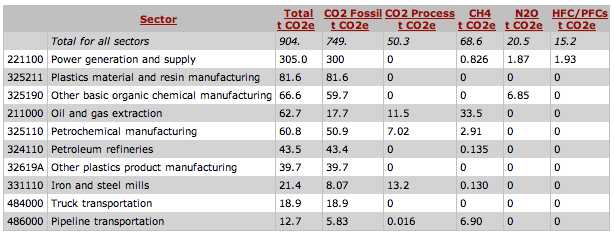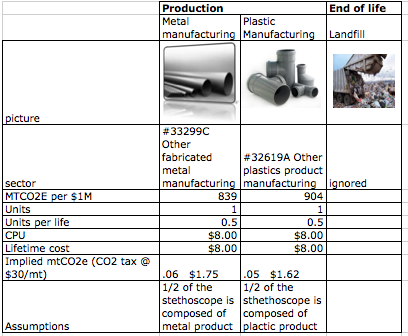Stethoscope
From DDL Wiki
Group Information
24-441 Spring 2012, Group 3
Kellen Chow (Wiki Formatting and FMEA Specialist)
Jacob Divone (Safety and Environmental Impact Specialist)
KinHang Leung (Team Leader and Manufacturing Specialist)
Cecily Sunday (Photographer and Design for Assembly Specialist)
Report 1 - Competitor Product Analysis
Project Executive Summary
A stethoscope is a medical device used for listening to internal body sounds. Our team is assessing the usability of a stethoscope used for medical applications. We researched the history of the stethoscope design to help determine how the product works. We also dissected a competitor stethoscope to study the construction, functionality and materials used in the assembly. We conducted a preliminary user study to develop ideas for improvement as well as features to consider during product dissection. Finally, we performed a life-cycle analysis to determine the environmental impact of manufacturing a stethoscope.
Our group determined that the design of the competitor stethoscope was robust enough for daily use and nearly optimized for cheap manufacturing and low maintenance. We recommend reducing the number of parts, specifically by cutting the number of tubes from two to one. We also recommend that the chestpiece be single-sided rather than double sided to reduce the movement of parts. Finally, we determined that there is a need for cheaper customization for individual products. Generic stethoscopes can be purchased for as low as $8.00, while customized stethoscopes can run over $300.00. We determined that having several customized parts that can be packaged with the stethoscope would allow for more individual customization with little extra cost to the consumer.
Stakeholders
| Stakeholder | Needs | Wants |
|---|---|---|
| Patient | Proper diagnosing of medical/physical condition Faster Diagnosis Happy medical provider lead to a more pleasant experience | Be as unobtrusive as possible |
| Physician | High sensitivity to noise transduction (Don't care about filtering ambient) Cost Quality | Comfort Easy to handle Stylish A way to ensure it won't get stolen/lost |
| Nurses | Medium sensitivity to noise transduction (Don't care about filtering ambient) Cost Quality | Comfort Easy to handle Stylish A way to ensure it won't get stolen/lost |
| First Responders | Sensitivity to noise transduction, more important to filter ambient noise Cost Quality | Comfort Easy to handle Stylish A way to ensure it won't get stolen/lost |
| Retailers | Ease of manufacturing Minimize time to manufacture Low cost to produce | Easy to market |
Product History
The first stethoscope was invented in 1816 and it has been an essential tool in medical diagnostic methods ever since. René Laennec of France first came up with the idea of a stethoscope when he examined a patient using a stack of paper rolled into a cylinder. The first stethoscope was simply made of wood. In 1852, the design of a binaural stethoscope was introduced and the new prototype replaced wood with rubber making it more flexible and comfortable to use. In 1865, a more sophisticated stethoscope was designed with ivory, steel and wood. In 1870, the design of stethoscope became standardized as binaural and was manufactured with steel, rubber and cotton for quality and durability. In 1998, the modern binaural stethoscope was invented and manufactured using stainless steel, rubber, nylon and plastic.
Product Functionality and Use
Three main components allow the acoustic stethoscope to transmit sound: a chest piece, an air filled tube, and a headset. In this medical device, vibrations are used to create pressure waves which travel from the source to the listener via air trapped in a hollow tube. While several design variations of the stethoscope exist, the theory behind each model remains the same.
The chest piece is responsible for capturing vibrations on a surface. Most chest pieces consist of a diaphragm or a plastic disk that vibrates in response to the surface sound. As the diaphragm vibrates, an acoustic pressure wave is created in the hollow interior of the chest piece. This pressure wave then travels through an air filled tube to the ear buds at the end of the headset where the sound reaches the listener. Many stethoscopes also have a bell, or an inverted cup situated opposite of the diaphragm. In contrast to the diaphragm, the bell creates pressure waves from the vibrations of the skin itself. The diaphragm is used to transmit higher frequencies while the bell transmits lower ones.
The stethoscope depicted in Figure 1 has two diaphragms located on the chest piece as opposed to a diaphragm and a bell. However, the smaller diaphragm functions the same as the bell because it is used to hear lower frequencies. The front, clear plastic side of either diaphragm is meant to be placed on the surface while the backs are to be screw into the stem, or the metal component that connects the chest piece to the tubing. Before using the stethoscope, the chest piece must be indexed, or turned appropriately so that airflow is directed through the correct path. Airflow is directed through a valve located in the stem.
The acoustics of the stethoscope will be affected if the path from the diaphragm to the headset is not airtight. Obstructions in its interior from dirt or related build-up will also affect the sounds quality of the stethoscope. For these reasons, frequent cleaning and maintenance is required to insure the stethoscope continues to function properly.
Preliminary Product User Study
Our group conducted a preliminary study to determine the proper use of the stethoscope. This medical device is used in a variety of settings, each with varying degrees of background activity and sound. For example, paramedics use the stethoscope in the field while doctors use this device in both emergency and office settings. Regardless of where it is being used, the stethoscope helps assess heart sounds, lung sounds, and blood pressure. This is done by applying the diaphragm or bell of the stethoscope to the chest, back, or inner arm (below the blood pressure cuff) respectively, depending on what sound is being assessed.
Step-by-step User Instructions
Observations from Preliminary User Study
During this study, it became apparent that all sounds are most difficult to hear in settings with an excess of background noise. Poor sound quality is exaggerated if the chest piece is not held steady against the surface that it is being applied to. If this piece slides, extra noise is transmitted through the headpiece. In the specific product that we studied, we found the headpiece to be incredibly uncomfortable to wear. The frame of the headpiece is made of metal, limiting the degree to which size readjustments can be made. In addition, the ear-buds on this product are made of a hard plastic material.
The acoustic quality of this devise will be greatly affected by loose parts or obstructions in the air path. While this stethoscope is assembled such that it can be taken apart for maintenance, some parts in particular, such as the interior of the headpiece, are tedious to disassemble and clean. Dust or particle buildup in this piece is therefor a likely contributor to diminished functionality.
From our observations, we compiled the following questions to pursue in a more detailed user study. Answering these questions will help us batter understand and innovate this product:
- How do the following parameters affect the acoustics of the stethoscope: diameter, length, and material of tube,vibration medium (air vs. water, material and shape of the ear buds, and single vs. double connecting tubes
- Would a visual representation of the frequency/input signal be desired by users?
- What criteria do people use in choosing which stethoscope to buy (cost, appearance, performance, comfort, etc.)?
Product Disassembly
The stethoscope can be broken down into 3 major components: Headset, Air-filled Tubes, Chestpiece
Headset
- The Eartips can be unscrewed from the Eartubes easily. (Design for easy replacement or customization)
- The Eartube Caps has to be removed by force and then the Headset can be separated from the tubes.
- The Triple-Leaf Spring and the Eartube Caps can then be easily slid off the Eartubes.
Air-filled Tubes
- The Rubber Tubes can be pulled off the Tube Pins on the Chestpiece by force. (Resulted in stretching and yielding part of the tubes)
- The Tube Clamps can be easily slid off the Rubber Tubes.
Chestpiece
- The Tube Pins can be unscrewed from the Stem.
- Each of the diaphragm pieces can be unscrewed from the Multi-head Chestpiece.
- For each diaphragm, the Ring can be unscrewed from the Base and the Film can be easily pushed out of the Ring. (Design for easy replacement and cleaning of the diaphragm)
- The Multi-head Chestpiece and the Stem are held on by a hidden screw under the Chestpiece Cap, which is held on by friction.
- After the screw is removed, the following components come out in the following order: Punched Washer, Spring, Washer.
- After every component is disassembled, we examined how the rotating mechanism work on the Chestpiece; the Spring provides just enough tension to push the Multi-head Chestpiece against a flat surface on the Stem, where a line groove keeps the Chestpiece in-line for every 180-degree rotation.
Bill of Materials
The major materials for the product are stainless steel, rubber and miscellaneous plastic parts. Our product is rather simple and has relatively less individual components and parts. The bill of materials is divided into 3 main sub-assemblies: headset, air-filled tubes, chestpiece. There are a few standard parts including a screw, washers and compression spring.
- ABS: Determined by deduction; it sinks in water (SG > 1.0), medium hardness, opaque, non-brittle, low-cost manufactured
- PE: Determined by deduction; it floats in water (SG < 1.0), ductile, transparent, non-brittle, low-cost manufactured
Design for Manufacturing and Assembly (DFMA)
The competitor product embodies a number of positive designs decisions to minimize costs and complications during the manufacturing process. This is done by using standardized components wherever possible, selecting easy to work with materials, and optimizing the stethoscope’s functionality by while maintaining its simplicity. After completing the DFM analysis, the chestpiece proves to be the component with the most room for improvement because this piece has the greatest number of customized parts associated with it. Perhaps a single, size-changing diaphragm can be designed to eliminate the need for all sound-splitting components.
The simplicity in the design of the stethoscope translates into simplicity of assembly. The competitor product utilizes a low part count, sub-assemblies, and mistake-proof processing to optimize the stethoscope's assembly design. The simplicity in design makes issues associated with obstructed pathways, sequencing, and direction almost inapplicable to the assembly of this product. With the exception of the sound splitting components, the stethoscope can be fully disassembled by the user for cleaning and maintenance. Therefore, as with the stethoscope's DFM, the chestpiece shows the most room for improvement in terms of DFA.
Positive DFM Features
- The stethoscope is not held together by any fasteners, lowering the part count.
- This design utilizes standardized ear-bud, washer, and screw components.
- The chestpiece and headset assemblies are connected and kept airtight using only the tension of the rubber tubes. This reduces the cost and complexity of the design by lowering part count and eliminating tight tolerances.
- All parts that must be machined are made of stainless steel. All other components are made of easy to work with materials such as malleable metals and plastics.
- Chestpiece has rough, finished surface inside of diaphragm, very different from other surfaces (possibly waterjet with particles, similar to shot peening). Possibly done for aesthetic reasons or for increased sound quality.
- The color of the tubing, ear-buds, and diaphragms can be easily changed according to the customer's preferences
- None of the plastic components require secondary or finishing operations
Suggested DFM Improvements
- The part count can be further consolidated by using a single instead of a double air tube. This would also eliminate the need for the two tube clamps.
- The chest piece should be simplified so that it requires less custom machining, moving parts, and tight tolerances.
- Different ear-buds can be selected that work to block out noise and improve comfort in addition to just transmitting sound.
- The diaphragm bases appear to be sand-blasted for aesthetics. This finishing operation can be eliminated to reduce manufacturing costs.
Positive DFA Features
- The chestpiece is the only component that requires specific tools and sequencing during assembly.
- The diaphragms, chestpiece, and headset are all sub-assemblies that can made and tested prior to the assembly of the final product.
- With the exception of the splitter,all components are connected using threads and chamfers, rubber tension, and/or light applied pressure.
- The size, color, and simplicity of the diaphragms and headset allow for mistake-proof assembly.
Suggested DFA Improvements
- Using a single air tube will eliminate the need to assemble the tube clamps.
- The tub caps have no functional purpose and can be removed to simplify the assembly process.
- The components in the chest piece must be well machined in order to be assembled properly.
- The sequencing and direction of the parts within the splitter is slightly ambiguous and may result in improper assembly.
Failure Mode Effects Analysis (FMEA)
A Failure Mode Effects Analysis (FMEA) is a tool used to determine the possible modes of failure for each component and subassembly of the product. It is also used to assign a Risk Priority Number (RPN) to help prioritize the highest likely risks and to aid in designing with safety as a priority.
Our FMEA was conducted after disassembling the stethoscope into its base components. The severity rating is on a scale of 1-10, 1 being imperceptible by the customer, 10 indicating a failure without warning. The occurrence rating is on a scale of 1-10, 1 being extremely remote (<0.0001% chance of failure) and 10 being extremely likely to occur (>50% chance of failure). The detection rating is on a scale of 1-10, 1 being almost certain detection and 10 being no chance of detection and no inspection.
| Part | Part Function | Failure Mode | Failure Effects | Severity | Cause(s) of Failure | Occurence | Detection | RPN | Recommended Actions |
|---|---|---|---|---|---|---|---|---|---|
| Low Frequency Diaphragm | Changes pressure in stethoscope to detect sounds | Diaphragm is punctured | Loss of stethoscope functionality | 5 | Impact Fracture | 3 | 3 | 45 | Inspect stethoscope before each use |
| Low Frequency Diaphragm | Changes pressure in stethoscope to detect sounds | Diaphragm surface is scratched | Reduced sound quality and functionality | 3 | Surface fatigue wear | 3 | 2 | 30 | Inspect stethoscope before each use |
| Low Frequency Diaphragm | Changes pressure in stethoscope to detect sounds | Diaphragm surface is warped | Reduced sound quality and functionality | 4 | Thermal/surface fatigue | 2 | 3 | 24 | Inspect stethoscope
before each use |
| High Frequency Diaphragm | Changes pressure in stethoscope to detect sounds | Diaphragm is punctured | Loss of stethoscope functionality | 5 | Impact Fracture | 3 | 3 | 45 | Inspect stethoscope before each use |
| High Frequency Diaphragm | Changes pressure in stethoscope to detect sounds | Diaphragm surface is scratched | Reduced sound quality and functionality | 3 | Surface fatigue wear | 3 | 2 | 30 | Inspect stethoscope before each use |
| High Frequency Diaphragm | Changes pressure in stethoscope to detect sounds | Diaphragm surface is warped | Reduced sound quality and functionality | 4 | Thermal/surface fatigue | 2 | 3 | 24 | Inspect stethoscope
before each use |
| Binaural Eartube | Translates sound to eartips | Eartube bent | Reduced sound quality and functionality | 2 | Yielding | 2 | 2 | 8 | Inspect stethoscope before each use |
| Eartips | Sits in ear canal, translates sounds | Eartips are scratched or deformed | User discomfort | 5 | Surface fatigue wear | 2 | 3 | 30 | Inspect eartips before each use |
| Rubber Tube | Translates sounds from stem to eartubes | Rubber tube is corroded | Reduced/loss of functionality | 5 | Impact/surface fatigue wear | 4 | 3 | 60 | Inspect tubes before each use |
| Triple-Leaf Spring | Stablize and maintain tension in eartubes | Spring is deformed | User discomfort, lack of tension in eartubes | 3 | High-cycle fatigue | 5 | 2 | 30 | Inspect spring before each use, perform fatigue tests after manufacturing |
| Tube Clamp | Keeps rubber tubes together | Tube clamp can deform, causing the rubber tubes to fall out | Minor inconvenience when tubes are loose | 2 | High-cycle fatigue | 2 | 2 | 8 | Inspect tube clamp before each use, run high-cycle fatigue tests after manufacturing |
| Tube Pins | Connects rubber tubes to chestpiece | Tube pins can fracture, leaving the rubber tubes with nothing to connect to | Loss of functionality | 6 | Brittle fracture | 2 | 2 | 24 | Inspect tube clamp before each use, run high-cycle fatigue tests after manufacturing |
| Screw | Connects stem to chestpiece | Screw can fail, causing the chestpiece to fall off entirely | Loss of functionality | 5 | Brittle fracture | 2 | 2 | 20 | Run high-cycle fatigue tests after manufacturing |
Design for Environment (DFE)
There are many other versions of stethoscope in today's market, some with additional features including electronic amplifier and monitors. Although our dissected stethoscope lack the fancy features, it is designed to consume zero energy in the Use Phase while minimizing the environmental impact in the Production Stage. Our only concern with its environmental impact is the choice of rubber material for the tubes and the amount of specialized machining required on certain parts. As shown below, we have utilized the EIO-LCA tool from the Carnegie Mellon website.
Production Stage
After searching through all the sectors listed on EIOLCA, we could not find a category the stethoscope fell into. In leu of this we decided to analyse the components of the stethoscope in their respective production stages. The stethoscope at its core can be broken down into manufacturing of plastics and metals. After searching through the sub sectors, we decided to use "Other plastics product manufacturing" and "Other fabricated metal manufacturing" subsectors.
To calculate the economic activity associated with the production of the plastics, 1 million dollars was used as the dollar input. With 1 million dollars, this would produce 125,000 stethoscopes. The results for 125,000 stethoscopes worth of plastic can be found bellow.
To calculate the economic activity associated with the production of the metals, 1 million dollars was used as the dollar input. With 1 million dollars, this would produce 125,000 stethoscopes. The results for 125,000 stethoscopes worth of metal can be found bellow.
The green house gas emissions produced from the manufacturing of the plastic can be found bellow.
The green house gas emissions produced from the manufacturing of the metals can be found bellow.
End of Life
The end of life analysis was not done for the stethoscope because it is going to wind up in a landfill.
EIOLCA Summary
Conclusion
The overall environmental impact of the stethoscope seems relatively small compared to other medical devices. When looking a the specific components of the stethoscope, it seems that the GHG produced from the manufacturing of the stethoscope was the highest, but even those emissions were relatively low per unit. If congress were to pass a tax on CO2 emissions, the cost to produce a single stethoscope would not be very effected.
References
Dieter, George Ellwood., and Linda C. Schmidt. Engineering Design. Boston: McGraw-Hill Higher Education, 2009. Print.
"History of Stethoscopes and Sphygmomanometers." Howard Hughes Medical Institute. Web. 24 Jan. 2012. <http://www.hhmi.org/biointeractive/museum/exhibit98/content/b6_17info.html>.
"Stethoscope Help Desk - Stethoscope Frequently Asked Questions." 3M Littmann Stethoscopes & Ultrascope Stethoscopes. Web. 23 Jan. 2012. <http://www.mystethoscope.com/help.php>.
"Stethoscope History." Inventors. Web. 24 Jan. 2012. <http://inventors.about.com/library/inventors/blstethoscope.htm>.
"Stethoscope." Wikipedia, the Free Encyclopedia. Web. 23 Jan. 2012. <http://en.wikipedia.org/wiki/Stethoscope>.
